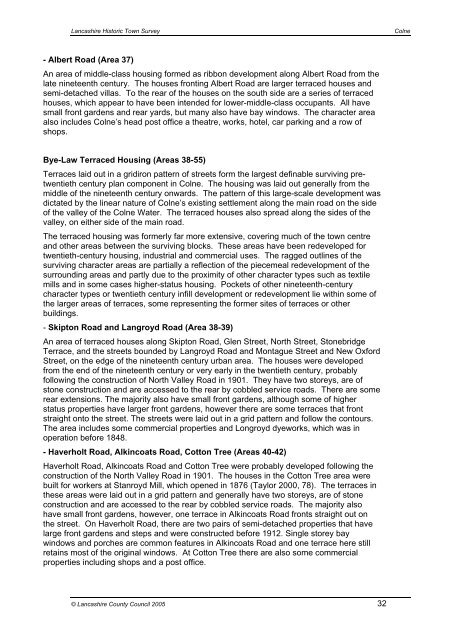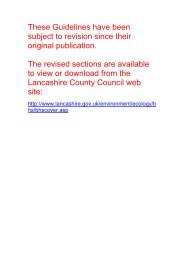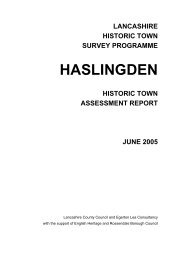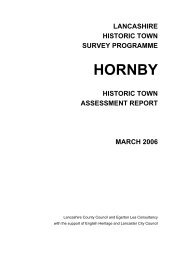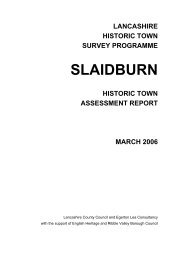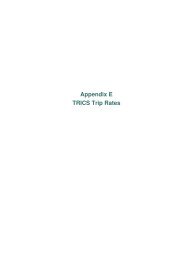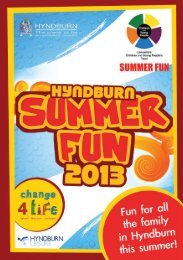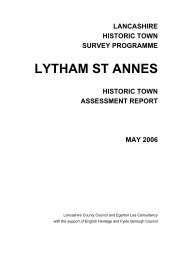Colne - Lancashire County Council
Colne - Lancashire County Council
Colne - Lancashire County Council
You also want an ePaper? Increase the reach of your titles
YUMPU automatically turns print PDFs into web optimized ePapers that Google loves.
<strong>Lancashire</strong> Historic Town Survey<strong>Colne</strong>- Albert Road (Area 37)An area of middle-class housing formed as ribbon development along Albert Road from thelate nineteenth century. The houses fronting Albert Road are larger terraced houses andsemi-detached villas. To the rear of the houses on the south side are a series of terracedhouses, which appear to have been intended for lower-middle-class occupants. All havesmall front gardens and rear yards, but many also have bay windows. The character areaalso includes <strong>Colne</strong>’s head post office a theatre, works, hotel, car parking and a row ofshops.Bye-Law Terraced Housing (Areas 38-55)Terraces laid out in a gridiron pattern of streets form the largest definable surviving pretwentiethcentury plan component in <strong>Colne</strong>. The housing was laid out generally from themiddle of the nineteenth century onwards. The pattern of this large-scale development wasdictated by the linear nature of <strong>Colne</strong>’s existing settlement along the main road on the sideof the valley of the <strong>Colne</strong> Water. The terraced houses also spread along the sides of thevalley, on either side of the main road.The terraced housing was formerly far more extensive, covering much of the town centreand other areas between the surviving blocks. These areas have been redeveloped fortwentieth-century housing, industrial and commercial uses. The ragged outlines of thesurviving character areas are partially a reflection of the piecemeal redevelopment of thesurrounding areas and partly due to the proximity of other character types such as textilemills and in some cases higher-status housing. Pockets of other nineteenth-centurycharacter types or twentieth century infill development or redevelopment lie within some ofthe larger areas of terraces, some representing the former sites of terraces or otherbuildings.- Skipton Road and Langroyd Road (Area 38-39)An area of terraced houses along Skipton Road, Glen Street, North Street, StonebridgeTerrace, and the streets bounded by Langroyd Road and Montague Street and New OxfordStreet, on the edge of the nineteenth century urban area. The houses were developedfrom the end of the nineteenth century or very early in the twentieth century, probablyfollowing the construction of North Valley Road in 1901. They have two storeys, are ofstone construction and are accessed to the rear by cobbled service roads. There are somerear extensions. The majority also have small front gardens, although some of higherstatus properties have larger front gardens, however there are some terraces that frontstraight onto the street. The streets were laid out in a grid pattern and follow the contours.The area includes some commercial properties and Longroyd dyeworks, which was inoperation before 1848.- Haverholt Road, Alkincoats Road, Cotton Tree (Areas 40-42)Haverholt Road, Alkincoats Road and Cotton Tree were probably developed following theconstruction of the North Valley Road in 1901. The houses in the Cotton Tree area werebuilt for workers at Stanroyd Mill, which opened in 1876 (Taylor 2000, 78). The terraces inthese areas were laid out in a grid pattern and generally have two storeys, are of stoneconstruction and are accessed to the rear by cobbled service roads. The majority alsohave small front gardens, however, one terrace in Alkincoats Road fronts straight out onthe street. On Haverholt Road, there are two pairs of semi-detached properties that havelarge front gardens and steps and were constructed before 1912. Single storey baywindows and porches are common features in Alkincoats Road and one terrace here stillretains most of the original windows. At Cotton Tree there are also some commercialproperties including shops and a post office.© <strong>Lancashire</strong> <strong>County</strong> <strong>Council</strong> 2005 32


